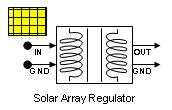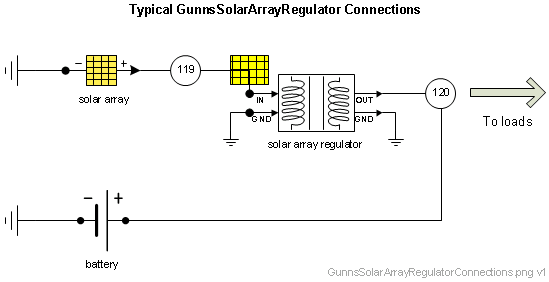GunnsSolarArrayRegulator - nasa/gunns GitHub Wiki

NOTE: this link is obsolete and replaced by GunnsElectPvRegConv.
This link is a specialized ConverterElect that regulates the output voltage of a SolarArray to vehicle loads. It can also control the output current through one of the loads -- this is typically used to trickle-charge a battery from the solar array at a specified current. The battery is typically a GunnsElectBattery link, but it can in fact be any GunnsBasicConductor or derived link type.
In typical operation, when there is enough sunlight incident on the solar panels, the solar array regulator will power the vehicle and charge the battery from the solar array. When there isn't enough sunlight, the input voltage from the solar array will drop until it can't sustain the vehicle loads, at which point the regulator will switch off the array and let the battery begin discharging and supplying the vehicle loads. When the sun comes back up, the regulator takes over the vehicle and begins charging the battery again, and so on.
This picture shows how to connect the GunnsSolarArrayRegulator link to nodes:

Port Connection Rules (These are limitations on the port connection to nodes that the link enforces in run-time):
- Ports 1 and 3 (the bottom-most ports on the shape graphic's input & output sides, respectively, can only be connected to the Ground node, like shown above.
Other Rules (These are extra rules you should always try to follow):
- N/A
Configuration Data Parameters:
- battery (default = 0, must not = 0): This is the address of the conductive load (such as a battery) to control the output current to. The syntax is &network->(link name), such as &network->battery.
- outVoltageSensorConfig: same as ConverterElect.
- outCurrentSensorConfig: same as ConverterElect.
- outputConductance: same as ConverterElect.
- converterOffConductance: same as ConverterElect.
- tripPriority: same as ConverterElect.
- standbyPower: same as ConverterElect.
- trickleChargeRate (default = 0 (amp), must be > 0): This is the desired rate at which the battery is charged when there is sufficient power available from the solar array.
- regulatedVoltageLowLimit (default = 0 (v), must be > 0): This defines the lower voltage limit that the regulator can control to.
- regulatedVoltageHighLimit (default = 0 (v), must be > regulatedVoltageLowLimit): This defines the upper voltage limit that the regulator can control to. While the regulator is feeding the vehicle loads and charging the battery, the regulated voltage can drift within these limits as needed.
Input Data Parameters:
- malfBlockageFlag: same as ConverterElect.
- malfBlockageValue: same as ConverterElect.
- outVoltageSensorInput: same as ConverterElect.
- outCurrentSensorInput: same as ConverterElect.
- malfOpOverCurrentFlag: same as ConverterElect.
- malfOpOverVoltageFlag: same as ConverterElect.
- malfRegulatedVoltageFlag: same as ConverterElect.
- inputVoltage: same as ConverterElect.
- regulatedVoltage: same as ConverterElect.
- efficiency: same as ConverterElect.
- outputOverCurrentLimit: same as ConverterElect.
- outputOverVoltageLimit: same as ConverterElect.
- outputOverCurrentTripActive: same as ConverterElect.
- outputOverVoltageTripActive: same as ConverterElect.
- inputOverVoltageLimit: same as ConverterElect.
- inputUnderVoltageLimit: same as ConverterElect.
- inputOverVoltageTripActive: same as ConverterElect.
- inputUnderVoltageTripActive: same as ConverterElect.
- proportionalGain (default = 0, must be > 0): This is the proportional gain on the P-D filter that the regulator uses to control the battery charge current. Higher values result in faster control to the desired charge current, but too high can cause oscillation in the output. Lower vales are more stable, but cause a slower approach to the desired charge current.
- derivativeGain (default = 0, must be > 0): This is the derivative gain on the P-D filter that the regulator uses to control the battery charge current. In general, values between around 10% - 25% of the proportionalGain usually work best.
- N/A
- N/A